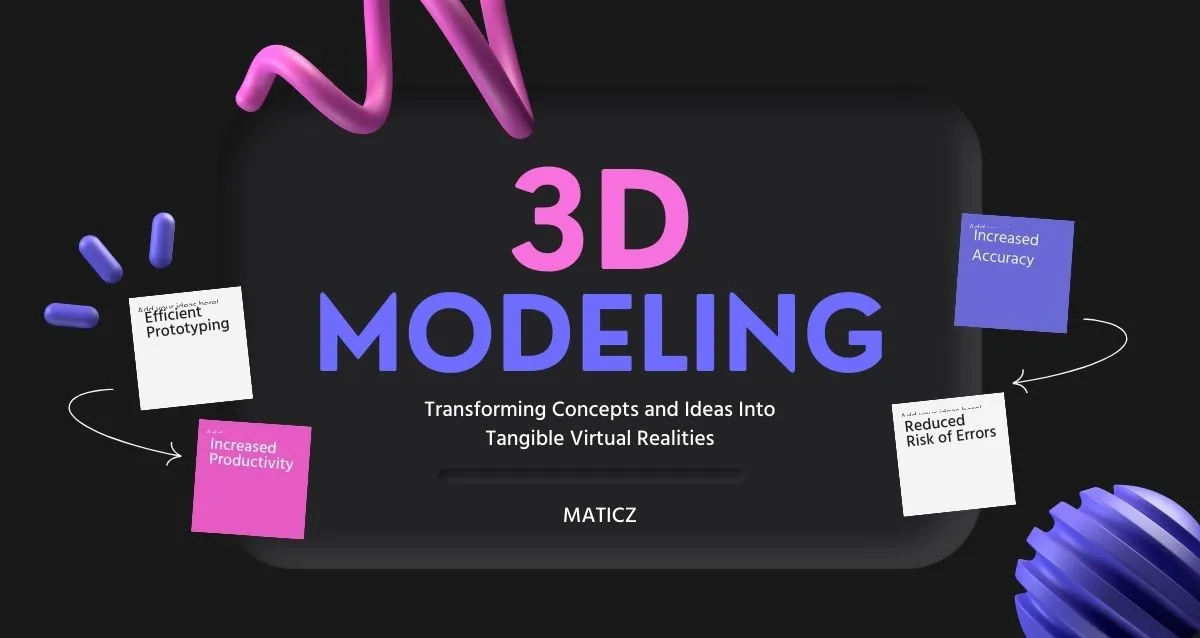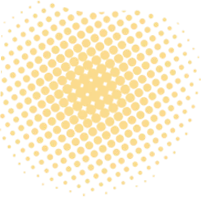Share Posts

What is 3D Modeling?
57
4131
103
It is fascinating to ponder how our environment is increasingly populated by 3D models. These models are more than just virtual representations of objects. They are complex digital constructs that capture the intricate details of real-world entities and enable us to visualize them in an entirely new way.
From buildings and landscapes to cars and consumer products, 3D models are transforming the way we perceive and interact with the world around us. With their ability to convey depth, texture, and shape, they bring a level of realism and detail to our experiences that were once impossible to achieve with traditional 2D images or physical objects alone.
In this blog, we have explored what exactly 3D modeling is, what it is used for, and how it works. Let’s dive deeper to know more in detail.
What is 3D Modeling?
3D modeling is a technique used to create three-dimensional representations of a person, an environment, or an object using specialized software. In 3D modeling, once a model is created, it can be manipulated, animated, textured, and rendered to produce images or videos for various applications.
Here the 3d models refer to the mathematical representations of a three-dimensional object in a computer graphics environment. It consists of geometric shapes, vertices, edges, and textures that define the object’s appearance in three-dimensional space.
We can create 3D models of already existing objects or something that has not yet been in real life. They can be created either manually, algorithmically, or by scanning. The process of 3d modeling has to do with points, lines, and polygons to make 3D shapes within the software.
Using the right set of tools and software, one can get started in 3d modeling. 3d models are made within a computer-based 3d modeling software. The purpose of 3D modeling is to get an accurate digital representation of a product because 2D images cannot present the product with its features in the best way.
How Does 3D Modeling Work?
3D models are made up of vertices that all come together to form a mesh. This mesh network acts as a core of the 3d model. Each point on the 3D model can be changed according to the shape we want. To locate each vertical and horizontal point relative to a reference point in the model, coordinate data is used.
The best way to get on with 3d modeling is, to begin with a basic shape such as a box, sphere, or cube which can be later molded and refined using 3d modeling tools according to whatever you think is best suited.
To put it simply, the workflow starts with an artist creating a basic shape using polygons like cubes, cylinders, planes, and spheres. From there, they use special 3D modeling tools to refine and perfect the design until it looks just the way they want it to.
This process involves adding points in the 3D space and tweaking their placement to manipulate the object's shape. By subdividing the polygons, one can create a whole new 3D object that looks completely different.
What is 3D Modeling Used For?
3D modeling is used for a variety of purposes such as rendering, simulation, animation, or manufacturing in a broad spectrum of industries. Whether it is for architecture, education, gaming, healthcare, or manufacturing, a 3D model can be used in countless ways.
It is not just a tool, but also a form of art that brings shape to the world around us. From everyday objects to things that seem impossible to create, 3D modeling can make it all possible.
Many industries have realized the full potential of 3D modeling and trying to make the most of it. Using a 3D model, you can create everything from animate to inanimate things with light effects, texture, and more.
Mainly, 3d modeling is used for rendering and simulation in businesses irrespective of their niche. Photo-realistic renders will be perfect for showing a project to a potential client whereas simulation works when it comes to technical applications without having to manufacture them.
Additionally, 3D printing takes your development process to the next level by visually presenting steps starting from rapid prototyping to production, thereby saving time and money. You might be surprised if you come to know still what are all the ways 3D models are used.
Types of 3D Modeling
3D modeling is a diverse field, and various techniques are employed to create digital representations of objects and scenes. Among the multitude of methods, three primary types of 3D modeling stand out. They are Wireframe Modeling, Surface Modeling, and Solid Modeling.
1. Wireframe Modeling
Wireframe modeling is the most basic form of 3D modeling. It represents objects solely through their outlines, consisting of lines and vertices that define the edges of the model. These wireframes provide a skeletal structure, emphasizing the shape and structure of the object without detailing surfaces or volume.
Applications:
1. Conceptual Design
2. Prototyping
2. Surface Modeling
Surface modeling focuses on defining the outer appearance of an object by creating its surfaces. Instead of emphasizing the internal structure, surface models concentrate on the external geometry, allowing for more detailed and visually realistic representations. Artists and designers use curves, patches, and other techniques to sculpt and shape surfaces, creating complex and aesthetically pleasing 3D models.
Applications:
1. Product Design
2. Character Animation
3. Solid Modeling
Solid modeling provides a comprehensive representation of an object by defining not only its surfaces but also its entire volume. In solid modeling, objects are treated as if they were made of real, tangible materials, and the model retains information about the object's interior.
Applications:
1. Engineering
2. Architectural Planning
Apart from these, still there are some advanced 3D modeling techniques which are as follows.
Polygonal Modeling
Polygonal modeling is a commonly used technique to create 3D models. It uses interconnected polygons, usually triangles or quads, which artists manipulate to build intricate shapes and surfaces. It's widely used in gaming, animation, and architectural visualization due to its versatility and efficiency in representing complex structures.
NURBS
NURBS is a method of mathematical modeling that uses curves and surfaces defined by control points. It excels in creating smooth and precise surfaces, making it ideal for industries where organic and free-form shapes are essential, such as automotive design and product modeling.
CAD
CAD is a technique used in engineering and product design to create accurate 3D models with precise measurements and specifications. These models form the basis for manufacturing, prototyping, and simulations.
Digital Sculpting
Digital sculpting allows artists to shape virtual clay as if they were working with traditional sculpting tools. This technique is useful in creating highly detailed and organic 3D models, particularly for characters and creatures in the entertainment industry.
Scan-based Modeling
Scan-based modeling involves creating 3D models by digitizing real-world objects or environments using 3D scanners. This technique is valuable for replicating existing physical objects with high accuracy.
Photogrammetry
Photogrammetry reconstructs 3D models from a series of 2D photographs. By analyzing the spatial relationships between images, the software generates accurate 3D representations of objects or landscapes.
3D Modeling Software
3D modeling software is a powerful tool that enables artists, designers, and engineers to create three-dimensional digital representations of objects, characters, environments, and more. These software applications provide a platform for shaping imagination into tangible and dynamic virtual creations.
This software typically offers a user-friendly interface with tools like selection, transformation, and manipulation to sculpt and modify objects. Users can apply textures to surfaces, enhancing the visual appeal of models with colors, patterns, and realistic materials.
Many 3D modeling software options come with pre-built material libraries for quick application.
Whether crafting characters, designing architectural wonders, or creating virtual environments, the right 3D modeling software serves as a versatile canvas for turning imagination into reality.
Here is a list of some of the popular 3D modeling software in 2024:
1. Autodesk 3Ds Max
2. SketchUp
3. FreeCAD
4. Blender
5. Cinema4D
Various Industries 3D Modeling Serves
The versatile applications of 3D modeling have permeated various industries, transforming the way professionals approach design, visualization, and problem-solving. Here we have listed down the industries where 3D modeling is widely used.
Healthcare
Whether 3d modeling serves other industries or not, this technique has surely come as a boon for the healthcare industry. 3D modeling is used in surgical planning and medical imaging. It can accurately recreate various body parts such as bones, organs, and tissues into 3d models that can be used for accurate medical diagnosis and treatment planning.
Using advanced imaging technologies, 3D prototyping, and CAD software, artificial models of anatomical parts and medical conditions are created that help medical professionals and surgeons decide on the treatment and surgeries clearly without any doubts. Also, it facilitates imparting medical knowledge to students and advanced medical research.
Architecture
Gone are the days when people used to draw blueprints with paper and pen. Before the building is fully built, we can see its three-dimensional visual, thanks to advanced technologies. 3D modeling goes beyond the traditional method of hand-drawn building plans. Using this technique, architects and designers create visual representations of buildings, interiors, and landscapes.
It is very useful in explaining their ideas to potential investors and clients. We can show them how our building will look once it is finished. Unlike in 2D models where issues can be spotted and fixed only when the building is complete, 3D models help to do so then and there. BIM modeling helps create 3D representations of a building’s geometry, materials, and construction schedules.
Media
By incorporating 3D modeling, one can present media in a better way and also make it a lucrative business. Nowadays it is impossible to watch movies that haven’t used 3D software.
In media, 3D modeling is used to create CGI characters, objects, animations, and environments to present real-life-like experiences in animated films and television shows.
Especially to create realistic visual effects (VFX) from bomb explosions, and car chases to incredible creatures and landscapes. Filmmakers can meticulously plan and create detailed sets, props, and visual effects, ensuring smooth collaboration between the set designers and the production team.
Gaming
The most common way of using 3D modeling is game development. With the need to create immersive and realistic gaming experiences for players, the gaming industry relies heavily on this technique. Game developers use 3D modeling to create characters, landscapes, and assets that feel more like real ones. They can manipulate 3D models and give them texture, color, and movement according to their needs using specialized 3D software.
Modern video games have started using advanced 3D modeling techniques such as virtual reality (VR) and augmented reality (AR) to take the gaming world to whole next level. They have transformed the way games are developed, allowing developers to combine fantasy and realism. In particular, virtual reality games allow players to dive and fully immerse themselves in a three-dimensional world. It would be hard to do all these things without 3D modeling.
Automotive and Aerospace
In the automotive and aerospace industries, 3D modeling is useful in the design and engineering of vehicles and aircraft. It helps simulate and analyze their aerodynamics, structural integrity, and performance. It is now easy to conduct virtual wind tunnel testing before the actual testing, thereby saving time and resources. Many commercials for cars and airliners feature 3D-generated imagery that looks so realistic making it hard to differentiate from real ones.
It is mainly used to design and test vehicles and their components before they are made. In aerospace, designers and engineers can test the aircraft’s design and how it interacts with the fuselage and air while flying. They can easily identify and resolve potential problems before building it physically. The strength and durability of the fuselage of aircraft can also be kept in check.
Product Design and Manufacturing
3D modeling is highly used in product design and manufacturing. Product designers create 3D models of their new products to have an idea of how they look before start making them in real. They can finetune their ideas and replicate the process as much as they want before finalizing the product. This cuts off the cost and time spent on unnecessary development processes.
They help manufacturers in precision machining, quality control, and assembly line planning to improve the entire workflow. It allows product designers and manufacturers to show their product concepts clearly and explain their perspectives to investors and clients. They can accurately visualize their end product, increasing the chance of cracking more business deals. There is no need to waste time and money on repeatedly creating prototypes and mockups.
E-commerce and Advertising
With the entire world moving on to e-commerce for buying products to purchasing homes, this advanced technique helps in various forms. In E-commerce and advertising, 3D modeling helps businesses uniquely present their products and services. They can create realistic 3D models of their products allowing customers to explore the items virtually before making a purchase. They can simply zoom in and examine details.
The 360-degree view helps spin the product like we do in real and configure color schemes with CG configurators to get a realistic shopping experience. Everything from texture, and size, to shape becomes clear to customers making them make informed decisions. You can walk your customers through your product by adding eye-catching and engaging movement to your 3D models. The exploded view feature breaks down the product to showcase its components, internal structures, and even the smallest details.
How To Build a 3D Model: A Comprehensive Guide
Building a 3D model is a dynamic and creative process that combines technical skills with artistic vision. Following these steps will help you navigate the intricacies of 3D modeling and bring your digital creations to life.
1. Define Your Objective
Before diving into the world of 3D modeling, clearly define your objective. Are you creating a character, architectural design, product prototype, or another object? Understanding the purpose of your 3D model will guide your decisions throughout the process.
2. Conceptualization and Planning
Sketch your ideas on paper or digitally. Consider proportions, dimensions, and key features. Plan the details you want to incorporate and map out the overall design. This conceptualization phase is crucial for establishing a roadmap for your 3D model.
3. Choose a 3D Modeling Software
Select a 3D modeling software that aligns with your project needs and your skill level. Popular choices include Blender, Autodesk Maya, 3ds Max, Cinema 4D, and SketchUp. Each software has its unique features and tools, so choose one that suits your workflow and objectives.
4. Start with Basic Shapes
Begin building your 3D model by creating basic shapes. These fundamental elements serve as the building blocks of your model. Common shapes include cubes, spheres, and cylinders. Arrange and modify these shapes to form the basic structure of your model.
5. Extrusion and Subdivision
Use extrusion to add depth and detail to your model. Extrusion involves pulling or pushing faces to extend or contract parts of the model. Subdivision allows you to add more vertices, creating smoother surfaces and more intricate details.
6. Refine and Sculpt
Refine your model by adjusting proportions, smoothing surfaces, and adding finer details. Some software provides sculpting tools for organic shapes, allowing you to mold and shape your model with precision. Continuously refine until you achieve the desired level of detail.
7. Apply Textures and Materials
Enhance the visual appeal of your 3D model by applying textures and materials. Consider the surface characteristics of real-world materials. Apply colors, patterns, and other visual elements to simulate the appearance of different materials, such as metal, wood, or fabric.
8. UV Mapping
For more complex models, perform UV mapping to ensure textures are applied accurately. UV mapping involves flattening the 3D surface into a 2D representation, allowing you to apply textures with precision.
9. Rigging and Animation
If your 3D model requires animation, set up a skeleton or rig to control movement. Define keyframes to create animations, such as walking cycles for characters or dynamic transformations for objects. Rigging is essential for giving life to your model in motion.
10. Test and Iterate
Regularly test your 3D model to ensure it meets your design objectives. Make necessary adjustments based on feedback or your own observations. Iterative testing helps refine and improve the final result, ensuring that your model aligns with your initial vision.
11. Rendering
Once satisfied with your 3D model, use the rendering capabilities of your software to produce high-quality images or animations. Configure lighting, camera angles, and other settings to achieve the desired visual outcome. Rendering brings your model to life by simulating lighting and shadows.
Final Thoughts
3D modeling stands at the forefront of creative and technological innovation, transforming concepts and ideas into tangible virtual realities. Whether it's bringing characters to life in the realm of gaming and animation, designing architectural wonders, or revolutionizing manufacturing processes through CAD, 3D modeling has become an indispensable tool across diverse industries.
And the best part is, as technology keeps advancing, the future looks even more exciting with new possibilities and limitless potential for digital design. So why not give it a try and see where your imagination takes you?
Maticz is a top software development company specializing in crafting all kinds of software including 3D modeling software. We have highly skilled designers and developers who can help you with crafting high-quality 3D models for a wide array of industries. Get in touch with us today to know more in detail.
Tap Into the Future
The latest insights, posts, and project updates - straight to your inbox.




